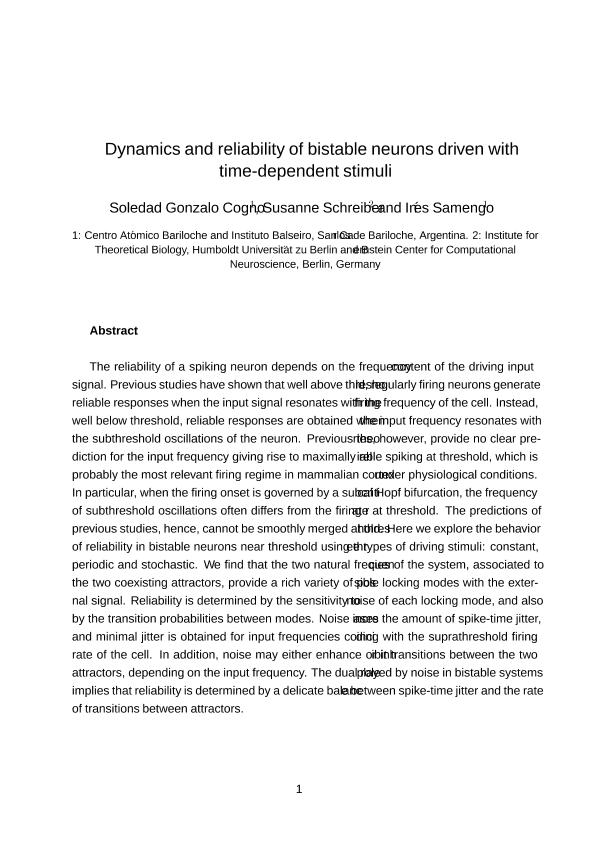Mostrar el registro sencillo del ítem
dc.contributor.author
Gonzalo Cogno, Ximena Soledad

dc.contributor.author
Schreiber, Susanne
dc.contributor.author
Samengo, Ines

dc.date.available
2017-07-26T20:45:35Z
dc.date.issued
2014-12-01
dc.identifier.citation
Gonzalo Cogno, Ximena Soledad; Schreiber, Susanne; Samengo, Ines; Dynamics and reliability of bistable neurons driven with time-dependent stimuli; M I T Press; Neural Computation; 26; 12; 1-12-2014; 2798-2826
dc.identifier.issn
0899-7667
dc.identifier.uri
http://hdl.handle.net/11336/21388
dc.description.abstract
The reliability of a spiking neuron depends on the frequency content of the driving input signal. Previous studies have shown that well above threshold, regularly firing neurons generate reliable responses when the input signal resonates with the firing frequency of the cell. Instead, well below threshold, reliable responses are obtained when the input frequency resonates with the subthreshold oscillations of the neuron. Previous theories, however, provide no clear prediction for the input frequency giving rise to maximally reliable spiking at threshold, which is probably the most relevant firing regime in mammalian cortex under physiological conditions. In particular, when the firing onset is governed by a subcritical Hopf bifurcation, the frequency of subthreshold oscillations often differs from the firing rate at threshold. The predictions of previous studies, hence, cannot be smoothly merged at threshold. Here we explore the behavior of reliability in bistable neurons near threshold using three types of driving stimuli: constant, periodic and stochastic. We find that the two natural frequencies of the system, associated to the two coexisting attractors, provide a rich variety of possible locking modes with the external signal. Reliability is determined by the sensitivity to noise of each locking mode, and also by the transition probabilities between modes. Noise increases the amount of spike-time jitter, and minimal jitter is obtained for input frequencies coinciding with the suprathreshold firing rate of the cell. In addition, noise may either enhance or inhibit transitions between the two attractors, depending on the input frequency. The dual role played by noise in bistable systems implies that reliability is determined by a delicate balance between spike-time jitter and the rate of transitions between attractors.
dc.format
application/pdf
dc.language.iso
eng
dc.publisher
M I T Press

dc.rights
info:eu-repo/semantics/openAccess
dc.rights.uri
https://creativecommons.org/licenses/by-nc-sa/2.5/ar/
dc.subject
Reliability
dc.subject
Bistable Neurons
dc.subject
Type Ii Morris Lecar
dc.subject
Dynamical Systems
dc.subject.classification
Biofísica

dc.subject.classification
Ciencias Biológicas

dc.subject.classification
CIENCIAS NATURALES Y EXACTAS

dc.title
Dynamics and reliability of bistable neurons driven with time-dependent stimuli
dc.type
info:eu-repo/semantics/article
dc.type
info:ar-repo/semantics/artículo
dc.type
info:eu-repo/semantics/publishedVersion
dc.date.updated
2017-07-24T12:51:28Z
dc.journal.volume
26
dc.journal.number
12
dc.journal.pagination
2798-2826
dc.journal.pais
Estados Unidos

dc.journal.ciudad
Cambridge
dc.description.fil
Fil: Gonzalo Cogno, Ximena Soledad. Comisión Nacional de Energía Atomica. Gerencia del _rea de Investigaciones y Aplicaciones No Nucleares. Gerencia de Física (cab). División Física Estadistica; Argentina. Consejo Nacional de Investigaciones Científicas y Técnicas; Argentina
dc.description.fil
Fil: Schreiber, Susanne. Center for Computational Neuroscience, Humboldt Universit ̈at zu Berlin and Bernstein; Alemania
dc.description.fil
Fil: Samengo, Ines. Comisión Nacional de Energía Atomica. Gerencia del _rea de Investigaciones y Aplicaciones No Nucleares. Gerencia de Física (cab). División Física Estadistica; Argentina. Consejo Nacional de Investigaciones Científicas y Técnicas; Argentina
dc.journal.title
Neural Computation

dc.relation.alternativeid
info:eu-repo/semantics/altIdentifier/url/http://www.mitpressjournals.org/doi/10.1162/NECO_a_00671
dc.relation.alternativeid
info:eu-repo/semantics/altIdentifier/doi/http://dx.doi.org/10.1162/NECO_a_00671
Archivos asociados
